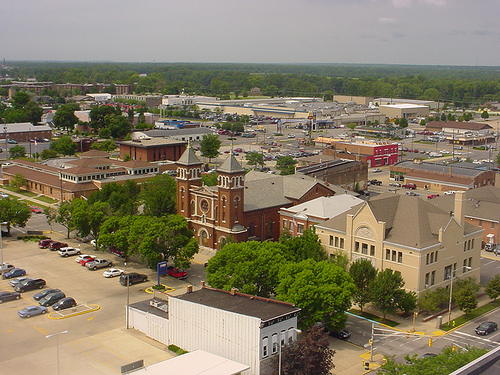
Moving to Terre Haute, Indiana: A Comprehensive Relocation Guide
Considering moving to Terre Haute, Indiana? This Wabash Valley city combines affordable living, multiple universities, and accessible small-city lifestyle. Here’s your 2025 guide.
Demographic Profile to Consider If Moving to Terre Haute:
Terre Haute, meaning “highland” in French, has a 2025 population of approximately 59,000 residents as the county seat of Vigo County. Located along the Wabash River near the Illinois border, Terre Haute serves as the commercial and cultural center of the Wabash Valley region. The metropolitan area encompasses about 169,000 people. With a median age of 33 years, the city maintains a youthful character influenced by three higher education institutions. The population is 80 percent White, 9 percent Black or African American, with smaller Hispanic and Asian communities. The city’s history includes manufacturing, distilling, and transportation industries that shaped its development, though the economy has diversified significantly since its industrial peak. Find trusted local services for moving, living, and working in Terre Haute.Terre Haute Relocation Directory
Cost of Living to Consider If Moving to Terre Haute:
Terre Haute ranks among Indiana’s most affordable cities. The median household income stands at approximately $42,000, while median home values hover around $110,000, making homeownership highly accessible. The homeownership rate is 54 percent. Rent, utilities, transportation, and daily expenses all fall well below national averages. Property taxes follow Vigo County’s moderate rates. However, the poverty rate of 27 percent reflects economic challenges, partly attributable to the large student population. Overall living costs provide excellent value for families, students, and retirees on fixed incomes. The combination of low housing costs and multiple employment sectors makes Terre Haute attractive for those prioritizing affordability.
Economy and Job Market:
Terre Haute’s economy employs approximately 24,000 people across diverse sectors. Healthcare and social assistance lead with 3,900 employees, dominated by Union Health and Terre Haute Regional Hospital. Education employs 3,600 workers across Indiana State University, Rose-Hulman Institute of Technology, Ivy Tech Community College, and K-12 schools. Retail trade provides 3,400 jobs. Manufacturing continues through the Vigo County Industrial Park and various plants. Major employers include the healthcare systems, universities, Pfizer pharmaceutical operations, and distribution facilities. The federal correctional complex also provides significant employment. The diversified economy helps maintain stability, though the region faces typical Rust Belt economic pressures. Average commute times are short at just 18 minutes.
Education:
Education stands as a cornerstone of Terre Haute’s identity. Vigo County School Corporation operates numerous elementary, middle, and high schools throughout the city. Indiana State University, the city’s largest higher education institution, offers comprehensive undergraduate and graduate programs. Rose-Hulman Institute of Technology consistently ranks among America’s top engineering schools, attracting talented students nationally. Ivy Tech Community College provides accessible vocational training and associate degrees. The concentration of three distinct higher education institutions creates educational opportunities rare in cities of this size. For K-12 families, both public and private school options exist, with varying performance levels across the district.
Recreation and Lifestyle:
Terre Haute offers relaxed Midwest living with surprising cultural depth. The city maintains over 30 parks and recreational facilities. Deming Park features walking trails, gardens, and event spaces. The Wabash River provides kayaking, fishing, and riverside trails. Downtown includes the historic Indiana Theater and locally-owned restaurants. The Swope Art Museum offers free admission to quality collections. Indiana State University athletics, particularly basketball, draw community support. The Wabash Valley features scenic rural landscapes just minutes from downtown. Terre Haute’s location provides convenient access to Indianapolis (70 miles east) and St. Louis (120 miles west). The small-city pace appeals to those seeking affordability and simplicity without sacrificing amenities.
Healthcare and Services:
Healthcare access in Terre Haute centers on Union Health and Terre Haute Regional Hospital, both providing comprehensive services including emergency care, surgery, and specialized treatment. These competing systems ensure quality care and drive medical innovation in the region. Numerous urgent care facilities, specialist practices, and medical offices operate throughout Vigo County. The presence of multiple healthcare systems creates good access and competitive pricing. For highly specialized care, Indianapolis hospitals are 70 miles away. The healthcare sector’s strength as a major employer also attracts quality medical professionals to the region.
Transportation:
Terre Haute benefits from strategic transportation positioning. Interstate 70 passes approximately 5 miles south of downtown, providing direct east-west connections to Indianapolis and St. Louis. U.S. Route 40 (the historic National Road) runs through the city. U.S. Route 41 provides north-south connectivity. The Terre Haute Transit Utility operates bus service throughout the city with seven day routes and three evening routes, and notably will offer fare-free service in 2025. Greyhound provides intercity bus connections. Terre Haute Regional Airport offers general aviation services, with commercial flights available through Indianapolis International Airport, 70 miles east. Historically a rail hub, the city lost passenger service in 1979, though freight rail remains active. Most residents rely on personal vehicles for daily transportation.
Conclusion:
Moving to Terre Haute in 2025 offers exceptional affordability, three quality universities, and genuine small-city Midwest living along the Wabash River, making it ideal for students, families, and anyone seeking value and simplicity in the Wabash Valley.

